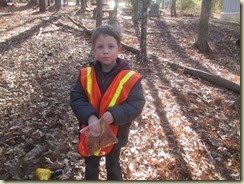Being a long, holiday weekend, we were fortunate to have a visit from our grandsons, Andrew and Owie here at J. Strom Thurmond COE. We had many activities planned, but we were somewhat stymied by some really cold weather.
That didn’t slow down the boys, they wanted to go pin hunting! Almost better than geo-caching. We bundled up and headed out to do some more boundary line verifications around Thurmond Lake.

We find it is much easier when we have helpers along with us. The boys were so handy in locating pins, digging, cleaning off the pin heads with a wire brush,

tying a pink ribbon on the pin and marking it as “Found” on our map.

With all the energy these guys burn, Mimi Marti wisely packed some snacks.

The boys were quite excited when we found a couple of encroachments by homeowners onto COE property. Here a homeowner pulled up the pin marker pole and tossed it aside to construct a porch.

I picked up the pole an tied it with the pink ribbon to a nearby tree for the park rangers to come out and deal with the situation.

Also, in the above picture, in the background, someone is setting up a 45 foot long house trailer about 40 feet over the COE property. The park rangers are going to have fun at this location.
After a busy morning walking through the woods, it was time for a lunch break. What do boys love to eat (besides candy)? Pizza, of course!

With a side of mozzarella cheese sticks.

After lunch, we were back out in the field, on to a new section of boundary lines. While walking, Andrew got something in his shoe, so he sat on a nearby tree stump to take off his shoe. Little did he know the stump was loaded with ants, but he found out quick! He started jumping around scratching like crazy.
Despite the cold air, we stripped him down and brushed off all the ants we could find. Then we bundled him up in our own coats and hustled off to the car. A shower and fresh clothes were in order. That finished our pin hunting for the day.
Because it was so cold out, we moved our evening campfire up to the Volunteer Village rec house, where we lit a fire in the fireplace and the boys roasted their hotdogs and made s’mores.

Over the rest of the weekend, we made good use of the rec house, it has plenty of room. Marti gave the boys their weekly piano lessons on her portable piano we have set up in the rec house.

Andrew and I worked on building his model car engine he got for his birthday.


He was quite proud of the finished product.

And what better way to pass some time than playing Mexican Train dominoes? Along with snacks, lots of snacks!

We wish we could have the boys more often, they sure make wandering around in the woods a lot easier…and more fun!
Some folks have asked about how we find boundary pins and how do we know the pins haven’t been moved. Here’s a quick “Pin 101”.
First all the pins have unique serial numbers and they are broken down into areas.

For example, a pin in area, say 99, will be marked 99-24, the next pin 99-25 and so on. Once the pin is located, we tie a bright pink ribbon on it to aid in finding in again in the future.
We are given Google maps with the boundary lines outlined and the approximate pin location overlaid on the map. (Sorry this isn’t the greatest picture, but you can enlarge by clicking on it).

We’re also given a map without the Google picture, which is easier to read.

In a perfect world, every pin would be marked by three trees, triangulated around the pin. The pin marking trees have three orange stripes and an orange dot at the top, called the “Eye”. The Eyes are all “looking” at the pin, and where the eye “lines” intersect, the pin is supposed to be.
Here is a perfect example, with the pin being one of the old orange cement monuments that were placed in the 1950s. It also has a modern marking pole.

Most modern pin markings look more like this, and the pin has replaced the cement monument.

Where it gets interesting is in some places, the marking trees have been cut or have fallen down, and/or the marking pole has been removed or destroyed. Often a homeowner has put lots of fill dirt to make a nice backyard lawn and buries the pin.
That’s where we have to use the metal detector to find the pin and once we get a hit, dig down to the pin to verify its location. If an unscrupulous person tries to move the pin, there are enough ways to find the pin’s true location, and we have seen that a couple of times. That’s for the park ranger to deal with.

Sometimes, we just can’t find the pin, for some reason it has been lost, removed or even washed away. We note it on the map and turn it in to the park ranger we’re working for. The ranger passes the info along and eventually a surveying team is sent out to relocate and replace the pin.
Basically, our pin hunting is like geo-caching on steroids. We enjoy the “thrill” of the hunt, the fresh air and the exercise. We both spent too much time in offices and cubicles during our working careers, so this is a very refreshing change. :c)
Thanks for visiting and feel free to leave a comment.
![license_20110706205528_24375[1] license_20110706205528_24375[1]](https://blogger.googleusercontent.com/img/b/R29vZ2xl/AVvXsEh8T6eq6wMrB5ikAOlOkVHPpd-SkZkMYvSIYYiDWs3gAR5niz6ffFAdnsC_PWjJlsIBmX9ay0ZKCiHvNVnFGw_r5YrBmNOsUGMKzqNJwggmHPzh-XNYsRP5aICA_Ji3DI1XfLlWaw9ERn16/?imgmax=800)





![woman_screaming1[1] woman_screaming1[1]](https://blogger.googleusercontent.com/img/b/R29vZ2xl/AVvXsEhU0T9mKbYbrIfcDpGBZ6znxZ2IyUTCiPbwYNUUEtITRgQ26okFWQmwhoJLZ62fRQ7-OtbxqXGGP4EaxseMRWcZyemDcO7aMGDEtPnXsercI9hpF55ph5rsMtM94RNx9uD5iQT25KdrfCcn/?imgmax=800)




![th[7] (2) th[7] (2)](https://blogger.googleusercontent.com/img/b/R29vZ2xl/AVvXsEiINfl8vlFCNZcBHAkjhBSll6V2pFEgKdiI67Tiq1I01tkW4ggpuNHarwphg5-R3uCxzIULB1SQGQSPdwj5w8an25aYHar-GfK20A1X8UjygThTq8kOQ8NxIycwoe0dnFcAAGDhKBKmqKde/?imgmax=800)
![license_20110706205528_24375[1] license_20110706205528_24375[1]](https://blogger.googleusercontent.com/img/b/R29vZ2xl/AVvXsEikXPUcWDnvf6GsQBFeyafRkzQ1rR6ALd9JpyvZBlTMLH3ccCa8BfdYtX00v8fn7FvnokzLwTNN12g4hRHmdtFJJQ_YtDbnHehMYDcXjkpVBa0LsitMMDyjowxt3heI0YXP7M5a87zKwhCs/?imgmax=800)


![license_20110706205528_24375[1] license_20110706205528_24375[1]](https://blogger.googleusercontent.com/img/b/R29vZ2xl/AVvXsEjrp5j8dQuBqFV3pL96hJEQTThrx4G9-MXZNsYv_0Z78LF9slTB1_C9CdGoQtyIi5h3V6uzBiDCCD03E98zlZCQu1Bbf9cU88K3jXGj2DjEyoDE2P9mJaIwUc6zuQe7C8COrTAzzr5gpVds/?imgmax=800)




















![license_20110706205528_24375[1] license_20110706205528_24375[1]](https://blogger.googleusercontent.com/img/b/R29vZ2xl/AVvXsEh8T6eq6wMrB5ikAOlOkVHPpd-SkZkMYvSIYYiDWs3gAR5niz6ffFAdnsC_PWjJlsIBmX9ay0ZKCiHvNVnFGw_r5YrBmNOsUGMKzqNJwggmHPzh-XNYsRP5aICA_Ji3DI1XfLlWaw9ERn16/?imgmax=800)


















![license_20110706205528_24375[1] license_20110706205528_24375[1]](https://blogger.googleusercontent.com/img/b/R29vZ2xl/AVvXsEggkZJRDlDqsFUpKUOuqX51s_O9t-bAgMNyUFXO2ZlCOuqCunoxFIin4ilw0HxBcs9V-e_Yk0YbdMMuHm-u5M2qwp3vtq-oxt2fCtxIJbrqfxi94e5MbW8Dyp_72tkSaClaPJ1a42XFu3WE/?imgmax=800)

